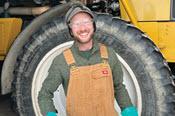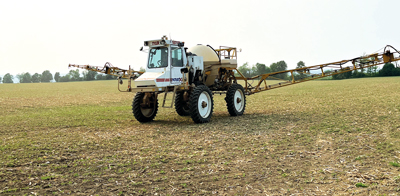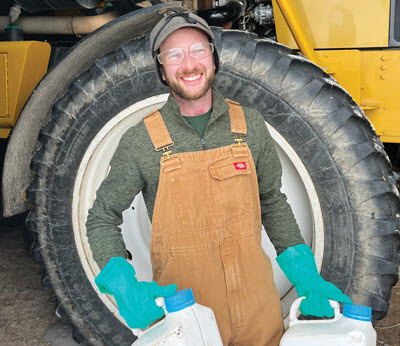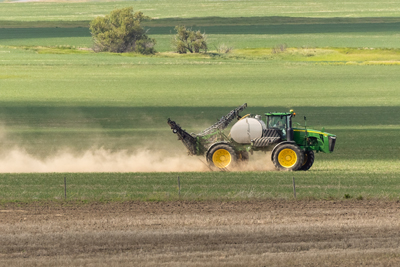
‘Read the label. That’s everything you need to know about the product.’
By Emily Croft
As the 2024 growing season approaches, many producers are thinking about what is needed to make this year’s crop the most successful yet. This includes planning to manage weeds, insects, and fungus in the fields. Ontario farmers should also remember to focus on safety when handling and spraying pesticides.
“Safety when handling pesticides is always important,” says James Dyck, engineering specialist of Crop Systems and Environment at OMAFRA.
“It needs to be the first thought. You are dealing with a chemical that is designed to control pests and weeds, and it is a hazardous material that needs to be treated with respect and caution.”
Each pesticide is different, so farmers should be familiar with the safety protocols specific to the products they are using. While the greatest risk of exposure is for the operator of the sprayer, it’s also critical that operators communicate with those around them.
What do farmers need to know to keep themselves safe while keeping their crops healthy?
The risks
Dean Anderson, a board member of the Canadian Agricultural Safety Association who recently retired from Workplace Safety & Prevention Services, says that being secretive while spraying is not safe.
“The biggest thing is to make sure people around you know what’s going on. Don’t be secretive because you don’t want people to get sprayed,” says Anderson.
Rob Forrest, regional sales manager, Prairies West for Nufarm, adds, “When you are spraying, you are in control of the product and should be familiar with it, but the people around you might not know what to do.”
Anderson explains that while everyone in the area needs to be informed of what is being sprayed, the biggest risk is personal exposure for the operator.
“Applicators need to be really cautious and read the label. If you have 2,000 acres to spray every year with the same herbicide, over 10 years and 20,000 acres you are getting more exposure compared to a worker in a barn who is milking cows,” says Anderson.

Insecticides present the greatest risk as their target is an animal and the mode of action is more likely to impact humans. Herbicides, which target plants rather than animals, tend to present a lesser risk but there is a potential for latent issues resulting from long-term exposure. It is important that applicators follow instructions to avoid exposure every time the product is handled, not just when there is a perceived immediate risk.
Exposure can occur a few different ways.
“The most obvious are contact with the skin or eyes,” says Forrest.
“You also have to worry about inhalation and absorption. The risk is not only getting splashed, but also the vapours and potential drift that comes off when handling those products. The No. 1 thing farmers should do is understand the product they are handling.”
Spills also pose a risk to the surrounding environment. Preparation and training are the best way to avoid spills and minimize their impact when they do happen.
Each product has a label that will describe the risks for the specific chemical and will explain how to minimize that risk.
Read the label
“Read the label. That’s everything you need to know about the product,” explains Anderson.
The label should be included with every box or tote of product and is also available from the manufacturer. It will detail mixing and application instructions, as well as listing all safety precautions. The label will tell producers how the product should be transported and stored, what PPE they need, what to do in the case of a spill, and what to do if they are exposed.
Producers should also review the Material Safety Data Sheet (MSDS) of each product to educate themselves about the potential hazards.
“The label is the law,” says Dyck.
“You need to follow the label, including handling, transport, and storage. If you don’t, technically you are not following law.”
If a product is commonly used on the farm, Dyck suggests obtaining an additional copy of the label to be stored in a safe place in the farm office. If it is easily accessible and everyone knows where to find it, it can be reviewed quickly in the case of an accident or simply if the operator needs a reminder on the protocols.
Anderson suggests that farmers keep a label in their pickup truck as well.
“Often there’s a paper label on the side of the jug. Take one and put it in the truck so it’s not smeared in water and mud, and you can read it. And then if someone goes in the truck, they know what you’re spraying as well,” explains Anderson.
He also suggests that producers review the label for products at least once annually, as they can change from year to year.
Be prepared
Preparation is the best way to avoid costly mistakes and reduce the risk of exposure or spills.
Reading the label should always be the first step before handling products, but there are additional ways that sprayer operators can plan ahead.
“Preparation is the best risk prevention in chemical handling,” explains Forrest, who recommends that producers take their time when handling chemicals, review the label, and set out all necessary supplies in advance.

“Always know what you’re handling, how to do it safely, who’s responsible for it, and who could be affected by your actions.”
All farm staff should be trained in safe pesticide handling, and the relevant contact details and all safety equipment must be easy to access for anyone involved.
“Farms with multiple staff should take time to remind each individual about safe handling of pesticides,” says Forrest.
“Make a checklist with steps for safe handling and preparation of commonly used products so everyone is aware. Make sure the necessary phone numbers are easily accessible and known to everyone if a spill were to occur, and that staff know who should be called. Not only should the business owner know, but also the people who are out in the field doing it.”
Dyck also recommends keeping a spill kit handy in pickup trucks and in the sprayer.
“Farmers can carry a spill kit in their sprayer and pickup truck. You can buy pre-made kits or assemble one yourself. It should have a shovel or broom and dustpan, a hazardous waste bag, a warning sign, extra PPE, and absorbent material,” says Dyck.
“Then if there were a spill, you would have everything you need to get started on clean-up.”
Record-keeping is another good way for producers to be prepared when handling chemical.
“Keep good notes. It doesn’t have to be in a computer database, but keep something that you can refer back to,” explains Anderson.
“Record the temperature, daylight, dew, what you mixed, and the rate you sprayed it at. Know what you sprayed and write it down. It’s your best defence if something goes wrong.”
Farmers should assess if the spill is small enough to contain itself if the worst does occur. If so, stop the source of the spill, ensure that people and animals are kept away from the area, and contain its spread with absorbent materials and barriers.
If the spill is too big to handle, it’s important that operators know the numbers to contact for direction.
Dyck says that in Ontario it is mandatory to report all spills to the Ministry of the Environment, Conservation and Parks, who will then give advice on how to clean up the spill and decontaminate the area.
Here’s the number to contact:
Ministry of the Environment,
Conservation and Parks
1-800-268-6060
PPE and staying clean
Personal protective equipment (PPE) needs to be worn every time chemical is handled to reduce the risk of exposure. The product label should detail which specific PPE items are needed.
“What you should wear and which safety gear you need – goggles, gloves, a respirator, or a Tyvek suit – should all be on the label,” says Anderson.
Forrest adds, “At minimum, make sure to cover as much exposed skin as possible and cover your eyes.”
Producers should always take time to put on goggles, which seal around the eyes, as opposed to glasses, and rubber gloves that will not absorb the chemical. Clothing should be a long sleeve shirt, but to avoid absorbing chemical, producers could also wear a repellent material like Tyvek.
The PPE worn when handling chemical is also only beneficial if it’s clean and well cared for.
“If you are wearing coveralls or spray clothes, keep them separate from household laundry.
“Run them through the wash twice and then run the washer without anything in it before washing anything else,” suggests Anderson. This will keep PPE clean without contaminating other clothes.
Forrest adds that people are more willing to use PPE when it is clean.
Once PPE has been cleaned, it should be stored somewhere clean, dry, and out of direct sunlight to avoid breakdown, Dyck says.
It should be frequently checked over for faults or cracks, as damaged PPE will be less effective.
Sprayer operators and anyone handling pesticides should always practise good hygiene. Hands, face, and any other exposed skin should be washed immediately after working with chemical.
Storing pesticides and sprayers
Proper sprayer maintenance reduces risks of spills and exposure to pesticides.
When operators are finishing up spraying the field, they should assess if they have product left in the sprayer.

“Generally, the best thing to do if you have a bit of waste spray is to speed up and spray the last bit on the field,” explains Anderson.
“You might apply a little extra, but most pesticides have a safety factor of twice the application rate on a specific crop.”
After the sprayer has been emptied, it should be cleaned as soon as possible to avoid any product drying in the machine, which could cause blockages or rust from corrosive chemicals. Improper cleaning can also lead to contamination when switching products and can damage crops.
“Cleaning is dependent on the product being used,” says Forrest.
“The best rule of thumb is to triple rinse the spray tanks and booms. Clean the filters and triple rinse them as well.”
Dyck adds, “Some more modern sprayers have a continuous rinse system. They have a separate container on the sprayer with clean water and once you’ve drained the tank, you use the rinse to inject clean water into the sprayer tank and continue to spray on the field. It’ll dilute the residue and flush out the boom.”
The sprayer should always be put away clean and should be frequently inspected to avoid leaky nozzles or hoses.
Pesticide should also be stored appropriately. Storage instructions will be on the label, but as a general rule, jugs and totes of chemical should have their own storage area.
“Storage is very important,” says Dyck.
“Under the Pesticides Act, it is illegal to store pesticides under unsafe conditions. What constitutes unsafe conditions might be different depending on the chemical.”
He says that they should be kept in a self-contained room dedicated to pesticides with proper ventilation and no floor drains.
The door should be secured with a lock and have signs to warn about potential hazards. The room should also be accessible from outside. Farmers may want to store different products away from each other to avoid cross contamination.
If precautions and labels are taken seriously, the risks associated with handling pesticide can be kept to a minimum. This growing season, make sure safety is a top priority when keeping fields clean. BF



Post new comment